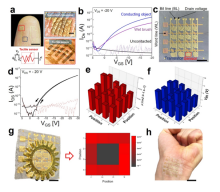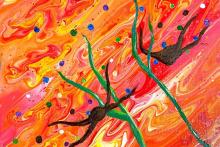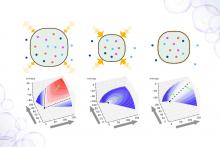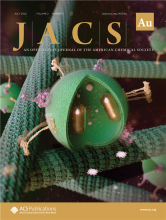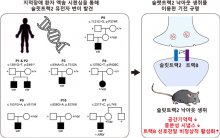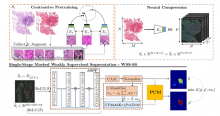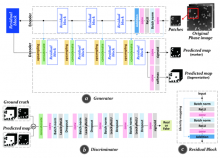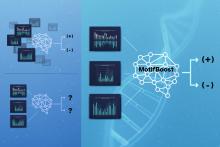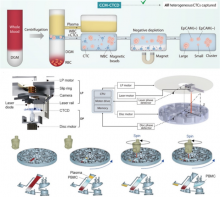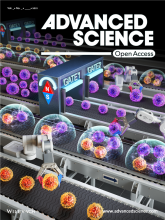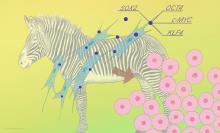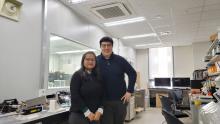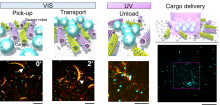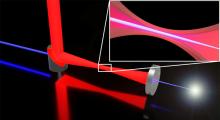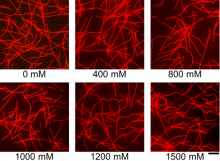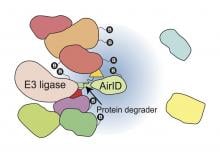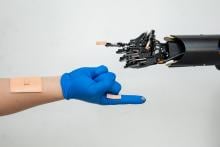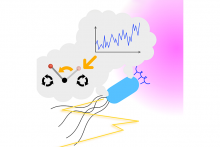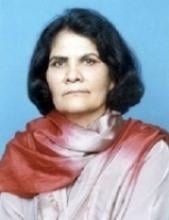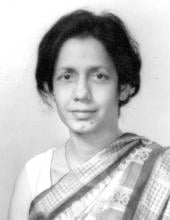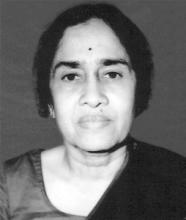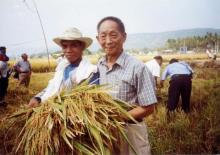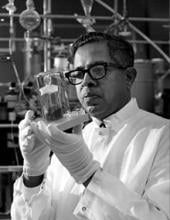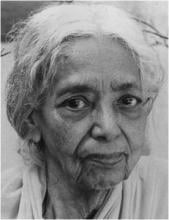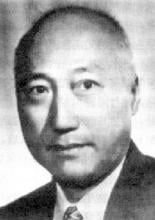Biotech
News
27 Sep 2022
- A research team led by Professor Lee Sungwon from DGIST succeeded in developing the world’s first mesh (nanomesh) structured electronic skin device (organic field-effect transistor)
- An electronic skin device comprising only a mesh (nanomesh) structure that can measure and process bio-signals for a prolonged period indicates a big step toward integrated systems for electronic skin devices.
20 Sep 2022
A research group led by the Institute of Industrial Science, The University of Tokyo, finds that sensory neurons in human skin modulate melanocytes via the secretion of Repulsive Guidance Molecule B
16 Sep 2022
Asia Research News monitors the latest research news in Asia. Some highlights that caught our attention this week are the best way to calm a crying baby, technology to sot sex in bovine semen, and a prosthesis for breast cancer patients made from an aquatic plant.
12 Sep 2022
Researchers at The University of Tokyo create a geometric representation of thermodynamic systems and apply it to self-replicating processes, which may help improve our understanding of the physical constraints of living organisms
23 Aug 2022
Two new approaches could help scientists use existing sequencing technology to better-distinguish RNA changes that affect how their genetic code is read.
10 Aug 2022
- DGIST Professor Seo Dae-ha's team developed a super-resolution microscopy that can observe 3D rotational motion of endosomes using gold nanoparticles
- By understanding cell transport more accurately through the observation of minute 3D rotation in intracellular transport, it is expected to develop into a disease diagnosis technology.
10 Aug 2022
- Joint research team of DGIST Professor Um Ji-won and Professor Ko Jae-won discovered several SLITRK2 synaptic adhesion gene mutations related to intellectual disabilities
- Identified the abnormal pattern in the signaling mechanism of SLITRK2 and presented a new therapeutic biomarker
10 Aug 2022
- DGIST Professor Park Sang-Hyun's research team developed a deep learning technology that accurately detects cancer sites with little information through joint research with a research team led by Professor Nam Su-jeong and Professor Ko Hyeon-Jeong of Seoul Asan Medical Center
- Expected to make significant contribution to enhancing the efficiency of deep learning models, which needed an accurately drawn dataset to detect cancer sites.
10 Aug 2022
- DGIST Professor Seo Dae-ha's team developed an experimental strategy to control and observe the chemical reaction of a single nanocatalyst using an optical microscope
- Expected to contribute to catalyst design based on accurate understanding of the photocatalytic reaction through an analysis method that helps understanding the electron excitation phenomenon and transition path.
10 Aug 2022
- Developed technology to accurately inspect the quality of red blood cells stored for a certain period of time with AI-based holography technology
- Possible to inject clean, healthy red blood cells into the patient. Expected to help minimize side effects of blood transfusion after surgery.
05 Aug 2022
Asia Research News monitors the latest research news in Asia. Some highlights that caught our attention this week are a treasure map for tracking ant biodiversity, tattoo ink that can monitor your health, and a newly discovered super-Earth.
20 Jul 2022
Researchers at the Institute of Industrial Science at The University of Tokyo introduce a machine learning method to help predict past infection from receptor sequences of immune T-cells even when little data is available, which may help improve human health and our understanding of adaptive immunity
22 Jun 2022
New dinosaur species used claws to graze along the coast, More accurate rainfall predictions, Magnetism helps futuristic cell research, Do compression garments facilitate muscle recovery? Science journalism and why it matters for democracy and our Image of the month. Read all in the June's Editor's Choice and this month's Asia Research News 2022 magazine pick - Lessons from the dead.
21 Jun 2022
A machine rapidly and robustly separates cancer cells from blood samples, overcoming challenges with currently available techniques.
20 May 2022
Asia Research News monitors the latest research news in Asia. Some highlights that caught our attention this week are smart contact lenses, cat communication, elephant mourning, and a hitchhiking drone.
13 May 2022
Molecular robots work cooperatively in swarms, LED lights made from rice husk, Muonic x-rays safely see inside samples, Making a luminescent material shine brighter and How to counter vaccine hesitancy, Read all in the May Editor's Choice and this month's Asia Research News 2022 magazine pick - Absorbing impact: Inside the Head of a Woodpecker.
03 May 2022
A new platform effectively sorts and clusters single cells according to their physical properties and could provide clues for understanding individual cell interactions.
26 Apr 2022
Researchers set out to find new ways to artificially induce mRNA to respond in ways that could eventually lead to therapeutic outcomes, expanding on the success of the mRNA-based COVID-19 vaccines and opening up new possibilities across a host of possible genetic therapies.
25 Apr 2022
Examination of endangered species’ stem cells unveils ancient genetic links between mammals.
25 Apr 2022
Coconut husk (CH), a solid biowaste derived from coconut, is typically used in household items, such as doormats. Recent studies have shown that CH is rich in lignocellulose, which can make for energy-related applications of CH. To this end, a global team of researchers, in a new study, make use of CH to develop self-powered energy storage and harvesting devices, achieving high energy density and output performance, and opening doors to a circular economy.
20 Apr 2022
In a global first, scientists have demonstrated that molecular robots are able to accomplish cargo delivery by employing a strategy of swarming, achieving a transport efficiency five times greater than that of single robots.
18 Apr 2022
An international team of researchers from India and Singapore has successfully developed a novel coating with enhanced water repellent properties using natural material from the waste crab shell.
11 Apr 2022
Researchers from Tohoku University have proposed a new method to form an electron lens that will help reduce installation costs for electron microscopes with atomic resolution, proliferating their use. Instead of the electrostatic and magnetic fields employed in conventional electron lenses, they utilized a light field electron-lens.
07 Apr 2022
The molecule trimethylamine N-oxide (TMAO) can be used to reversibly modulate the rigidity of microtubules, a key component of molecular machines and molecular robots.
21 Mar 2022
The theme of MTE 2022 is "Embracing the New Norm and Moving to New Frontiers," and this prestigious event is expected to attract over 10,000 online visitors from all over the world via its virtual exhibition platform.
21 Mar 2022
Electrical stimulation of nerve fibers could promote the growth of the myelin sheath, a protective layer around neurons that is crucial for transmitting nerve impulses. The finding, published in the journal Biofabrication, introduces a new paradigm in the treatment of diseases where the myelin sheath is progressively lost, leading to muscular atrophy, hand and foot deformities, gait abnormalities, and paralysis.
09 Mar 2022
An analysis method for protein–protein interactions using proximity-dependent biotinylation for next-generation drugs
23 Feb 2022
The coronavirus pandemic has accelerated the use of robots and an urgent need for an advanced human-machine interface (HMI) system that can seamlessly connect users and robots. A research team co-led by City University of Hong Kong (CityU) and collaborating institution recently developed an innovative HMI system, which consists of flexible, multi-layered electronic skin and provides both visual and haptic feedback to users. The system can teleoperate the robot to imitate the user's actions to perform complicated tasks. It demonstrates the potential for conducting Covid-19 swab tests and nursing patients with infectious diseases.
15 Feb 2022
Researchers at The University of Tokyo demonstrate the theoretically optimal search method for organisms that employ the “run-and-tumble” technique, and find that it conforms with observations of chemotaxis by E. coli, which may help automate drones
Events
Sorry, no events coming up for this topic.
Researchers
Sorry, no researchers coming up for this topic.
Giants in history
Pakistani botanist Azra Quraishi (22 September 1945 – 22 November 2002) is recognised for developing virus-free seed potatoes that increased potato production in Pakistan by an estimated five per cent.
Indian botanist Shipra Guha-Mukherjee (13 July 1938 – 15 September 2007) made a breakthrough discovery that enabled the genetic study of plants and, by extension, the development of improved varieties of rice, wheat, potatoes, and other crops.
Japanese chemist Takamine Jokichi (3 November 1854 – 22 July 1922) founded the Tokyo Artificial Fertilizer Company, where he isolated a starch-digesting enzyme (named takadiastase) from the fungus Aspergillus oryzae.
Filipina chemist María Orosa (29 November 1892–13 February 1945) fought malnutrition and food insecurity in the Philippines by devising over 700 culinary creations including Soyalac, a nutrient rich drink made from soybeans, and Darak, rice cookies packed with Vitamin B1, which could prevent beriberi disease caused by Vitamin B1 deficiency. She was also a partisan of the guerrilla movement resisting Japanese occupation during World War II, and died after being struck by shrapnel while working in her laboratory during the Battle of Manila.
Chinese biochemist Cao Tianqin (5 December 1920 – 8 January 1995) discovered the myosin light chain, a subunit of myosin, a protein crucial for muscle contraction.
In 1939, biochemist Kamala Sohonie (18 June 1911 – 28 June 1998) became the first woman to be accepted into the Indian Institute of Science (IISc).
Chinese agronomist Yuan Longping (7 September 1930 – 22 May 2021) developed the first varieties of the high-yield, hybrid rice that brought food security to multiple countries including China, which had been ravaged by food shortages as recently as the mid-20th century.
David T. Wong (born 1936) is a Hong Kong-born American neuroscientist who is best known for discovering the antidepressant drug fluoxetine, better known as Prozac.
Cyril Andrew Ponnamperuma (16 October 1923 – 20 December 1994) was a Sri Lankan chemist who was interested in the origins of life on Earth. His research in chemical evolution showed how inanimate molecules may have given rise to the building blocks of life – a process known as abiogenesis.
Osamu Shimomura (27 August 1928 – 19 October 2018) was a Japanese organic chemist and marine biologist who dedicated his career to understanding how organisms emitted light.
Janaki Ammal Edavalath Kakkat (4 November 1897 – 7 February 1984) was an Indian botanist who studied plant chromosomes and genetics.
Gopalasamudram Narayanan Ramachandran (8 October 1922 – 7 April 2001) is best known for developing the Ramachandran plot to understand the structure of short chains of amino acids, known as peptides.
Hsien Wu (24 November 1893 – 8 August 1959) is widely regarded as the founder of biochemistry and nutrition science in China. He was the first to propose that protein denaturation was caused by the unfolding of the protein, instead of chemical alteration.
Umetaro Suzuki (7 April 1874 – 20 September 1943) was a Japanese scientist best remembered for his research on beriberi, a disease caused by vitamin B1 deficiency, characterized by limb stiffness, paralysis and pain.
Maqsudul Alam (14 December 1954 – 20 December 2014) was a biologist from Bangladesh who is renowned for his research on genome sequencing
Barry Paw (29 August 1962 – 28 December 2017) was a biologist and oncologist who discovered several novel genes and their functions in red blood cells.
Gloria Lim (1930-2022) was a mycologist from Singapore who studied tropical fungi. One of the first students to attend University of Malaya when it was founded in 1949, she went on to become the first female Dean of the Faculty of Science at the University of Singapore.


